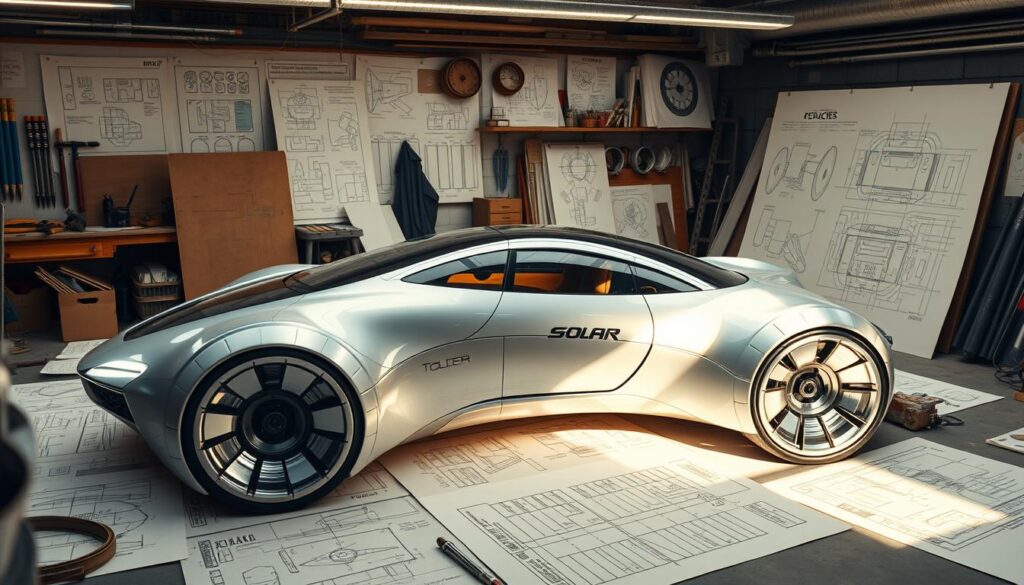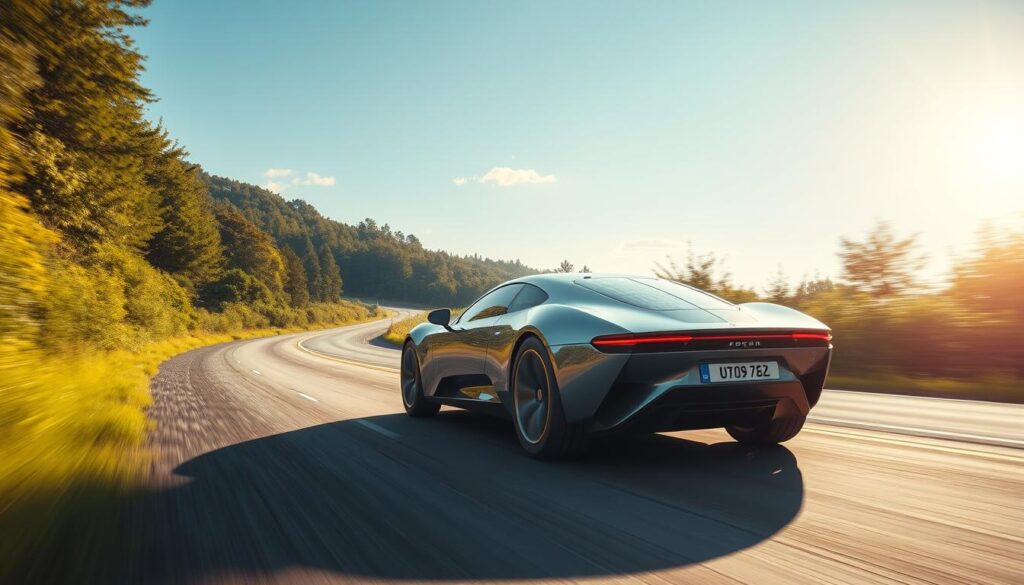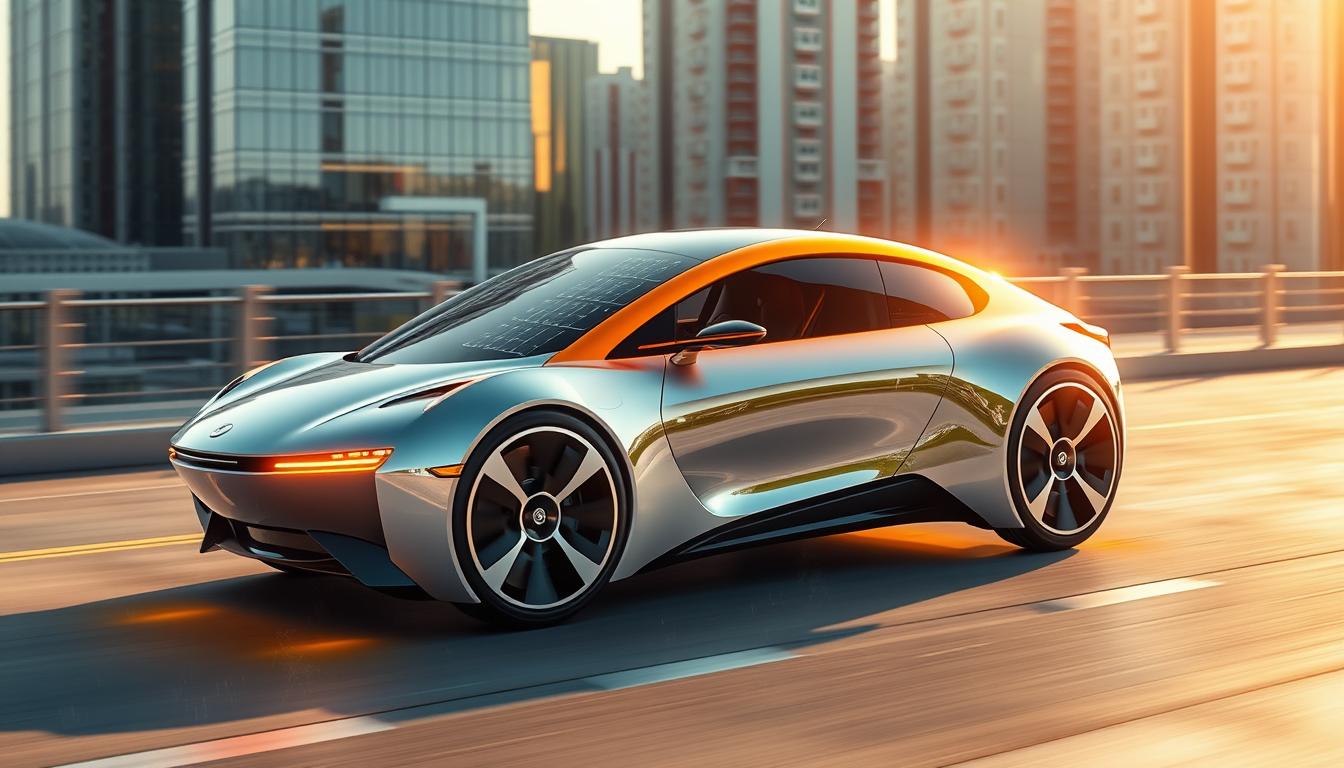Ever wonder why we’re not all driving in cars powered by the sun? We have solar panels on roofs, so why not in cars? It’s a question that has puzzled me lately. Exploring solar car technology, I find the path to green vehicles is full of obstacles.
Imagine sleek, futuristic cars moving quietly on the highway, powered by sunlight. It sounds like something from science fiction, right? But, solar powered cars do exist. They’re mostly seen in races, not in dealerships. So, why aren’t they on Main Street USA?
Key Takeaways
- Solar cars exist but are mainly seen in events like the World Solar Challenge
- The average car’s surface area can only collect about 684 watts of usable solar energy
- A typical car needs around 20,000 watts to drive at highway speeds
- Geographic location and weather conditions significantly impact solar energy generation
- Current solar car technology faces challenges in reliability for everyday transportation
The Allure of Solar-Powered Vehicles
I’m excited about the future of green travel, and solar cars lead the way. These cars show us a world where our daily trips could run on sunlight.
Environmental Benefits
Exploring eco-friendly cars, I see their big environmental win. Solar cars could cut down a lot of pollution from cars, which is a big problem in the U.S.
Energy Independence
The idea of not needing gas stations is very attractive. Some solar cars can go up to 40 miles on just sunlight. This means no more stops for fuel, making our travel truly independent.
Futuristic Appeal
The designs of solar cars are truly eye-catching. Aptera’s three-wheeler is a perfect example. It’s not just a car; it’s a symbol of our future in green travel. These designs are for those who want the latest in eco-friendly living.
“Solar-powered cars are not just vehicles; they’re a statement about our commitment to a cleaner, more sustainable future.”
Solar cars are a big step towards a greener, more independent travel future. They’re exciting, but we face challenges. Let’s dive into the science behind this promising tech.
The Science Behind Solar Car Technology
I’ve always been fascinated by solar-powered vehicles. Let’s explore the science behind them. Photovoltaic car systems turn sunlight into energy.
Photovoltaic Cells and Energy Conversion
Photovoltaic cells are the key. They capture sunlight and turn it into electricity. It’s like a tiny power plant on your car!
Electrons get excited by sunlight and create an electric current. It’s pretty cool, right?

Solar Panel Efficiency
Solar panels aren’t as efficient as we’d like. They usually get about 20% of the sun’s energy. That’s only a fifth.
But, electric vehicle innovation is working to improve this. We still have a long way to go.
| Solar Panel Type | Efficiency | Cost |
|---|---|---|
| Monocrystalline | 22% | High |
| Polycrystalline | 18% | Medium |
| Thin-Film | 15% | Low |
Energy Storage Systems
What happens when it’s dark? That’s where energy storage comes in. Batteries store extra energy for later.
The challenge is balancing battery weight with energy needs. It’s like packing for a trip without knowing how long you’ll be away!
As electric vehicle innovation grows, we see new developments. Maybe soon, we’ll all drive cars powered by sunshine!
Current State of Solar Car Development
I’ve been watching the green automotive engineering world closely. It’s an exciting time for cars powered by renewable energy. Solar cars are moving from dreams to reality!
Startups are leading the way in making solar cars practical. Aptera, Lightyear, and Sono Motors are merging solar power with electric charging. They’re creating vehicles that are truly ahead of their time.
These solar-electric hybrids are still in testing but are available for pre-order. I’m looking forward to their release in 2023. It’s a glimpse into the future!
These prototypes can get 7 to 40 miles of charge per day from the sun. This varies with weather and design. But it’s a great start for green cars!
| Company | Vehicle Model | Solar Range (miles/day) | Expected Release |
|---|---|---|---|
| Aptera | Three-Wheeler EV | 40 | 2023 |
| Lightyear | Lightyear One | 12 | 2023 |
| Sono Motors | Sion | 21 | 2023 |
As renewable energy vehicles improve, we’re on the edge of a big change. The future of driving is getting brighter and cleaner!
Why Don’t They Make Solar Powered Cars?
I’ve often wondered why solar powered cars aren’t zipping around our streets. As I explore sustainable transportation, I question the lack of these futuristic vehicles. Let’s look at what’s holding back solar car technology from becoming common.
Limited Surface Area for Solar Panels
The biggest challenge in making solar cars is the space for solar panels. I find it funny to think about adding more panels to my car. Sadly, most cars don’t have enough room to make enough power for daily driving.
Insufficient Energy Generation
Solar panels on cars can’t make enough power, even in the best conditions. I did some math, and it’s surprising. A car with solar panels might make about 684 watts. But driving on the highway needs 20,000 watts. That’s a huge difference!
Weather and Geographic Limitations
Weather and where you live also affect solar energy. Imagine driving in Seattle on a rainy day in a solar car. You’d be going nowhere fast!
These issues make solar cars hard to compete with regular electric or gas cars. Solar car tech is getting better, but we still don’t see them on our roads. The search for sustainable transport goes on, but solar cars are still a dream for now.
Challenges in Solar Car Design
Exploring eco-friendly car design, I see the tough challenges engineers face. Making a solar car isn’t simple. It’s about finding the right balance between looks and performance.

Aerodynamics vs. Solar Panel Placement
It’s hard to mix aerodynamics with solar panels. Cars need to be sleek, but solar panels don’t fit well on them. Designers try out creative solutions, like folding panels or flexible skins.
Weight Considerations
Solar panels and batteries add a lot of weight to cars. This affects how far they can go. It’s a constant trade-off. The aim is to make a car that’s light yet powerful.
Aesthetics and Consumer Appeal
Beauty is important. Even the most efficient solar car won’t sell if it looks bad. Designers must make cars that are both efficient and attractive. It’s about creating something people want.
Overcoming these challenges is exciting. As tech improves, I look forward to seeing solar cars that are both stylish and eco-friendly. They’ll make our roads cleaner and our planet greener.
The Role of Solar in Electric Vehicles
I’ve been looking at the latest electric vehicle innovation, and it’s really exciting. Solar tech is making a big splash in electric cars. It’s like having a piece of the sun on your car roof!
Imagine driving your electric car and knowing the solar panels are helping your battery. It’s not just a dream anymore. Engineers have made solar panels for cars, which could reduce charging needs by up to 15%. That’s like getting a free pizza with every six you buy!
This tech mix is really cool. For example, the 2020 Hyundai Sonata uses solar power, electric charging, and a gas engine. It’s like a Swiss Army knife of cars!
We’re not getting rid of charging stations yet. But solar power in EVs is a big step towards a greener future. It’s like we’re making a recipe for sustainable cars, and solar power is the key ingredient.
“The future of transportation is bright… and solar-powered!”
So, when you’re looking for a new car, watch for those solar panels. They might be the coolest thing your new ride has!
Promising Solar Car Startups and Prototypes
I’ve been following some exciting news in solar car tech. It’s amazing to see new ideas in green transport. These startups are changing the game with their unique designs.
Aptera’s Three-Wheeled Wonder
Aptera’s three-wheeler is making a big splash. It can get up to 40 miles of charge from the sun every day. Starting at $25,900, it’s affordable and eco-friendly.

Lightyear One: Bridging Solar and Electric
Lightyear One is a game-changer in electric cars. It uses solar power to add about 7.45 miles for every hour of charging. Though pricey at 150,000 Euros, it’s leading the way for green cars.
Sono Sion: Bringing Solar to the Masses
Sono’s Sion wants to make solar cars common. It can get about 69.5 miles of charge from the sun weekly. This is a big step towards making solar cars for everyone.
| Model | Daily Solar Range | Starting Price |
|---|---|---|
| Aptera | 40 miles | $25,900 |
| Lightyear One | 59.6 miles | 150,000 Euros |
| Sono Sion | 9.9 miles | 25,126 Euros |
These startups are shaping the future of solar cars. They face challenges, but their work is inspiring. It shows us a greener transport future is possible.
Economic Factors Hindering Mainstream Adoption
I’ve been exploring green automotive engineering, and it’s not easy. The cost of these eco-friendly cars is high. The Sono Sion costs $32,261, and the Lightyear One is $169,767.
Clean energy mobility is appealing, but it’s pricey. Here’s a look at the costs:
| Solar Car Model | Price (USD) | Comparable EV Price (USD) |
|---|---|---|
| Sono Sion | 32,261 | 25,000 (Nissan Leaf) |
| Lightyear One | 169,767 | 79,990 (Tesla Model S) |
| Aptera (Solar EV) | 25,900 – 46,900 | 31,995 (Chevy Bolt EV) |
Making solar cars affordable is a big challenge. They can’t compete with traditional electric vehicles yet. We need a breakthrough in green automotive engineering.
I dream of driving a solar car one day. But for now, it’s just a dream. The sun isn’t ready to power our cars yet.
Overcoming Technical Limitations
I’ve been exploring solar-powered cars, and it’s exciting! Tech experts are working hard to improve photovoltaic car systems. They’re like mad scientists, but they’re making cleaner, greener cars instead.
Advancements in Solar Cell Efficiency
Imagine solar cells so good they could power your car and your neighbor’s coffee maker. It’s not quite there yet, but researchers are looking into organic materials for solar cells. They’re like giving these cells a superhero boost!
Innovative Energy Storage Solutions
Energy storage is a big deal for solar cars. Scientists are finding new ways to store solar power. These breakthroughs could make solar panel integration in cars as easy as adding cup holders.
Integration of AI and Smart Technology
Picture your car being smarter than your smartphone. That’s where we’re headed with AI in solar cars. These cars could use energy more efficiently, making solar cars more practical. It’s like having a tiny Einstein in your car, always finding ways to use more sunlight.
FAQ
Why aren’t solar-powered cars mainstream?
What are the environmental benefits of solar-powered vehicles?
How do solar cars convert sunlight into electricity?
What are some promising solar car startups and prototypes?
What are the economic factors hindering mainstream adoption of solar cars?
How can the technical limitations of solar cars be overcome?
Source Links
- Why aren’t there solar-powered cars on our roads? – https://www.popsci.com/technology/why-arent-there-solar-powered-cars/
- Why don’t solar-powered cars exist? – https://www.motorauthority.com/news/1132588_why-don-t-solar-powered-cars-exist
- PDF – https://solarschoolhouse.org/solar-cars-solar-powered-cars-could-soon-hit-the-streets-freethink-20211223/




Interesting article, but isnt the production of solar panels itself a pollution-heavy process? Just playing devils advocate here.
Interesting read, but arent we ignoring the fact that solar panels are not efficient in all weather, like, what about cloudy days?